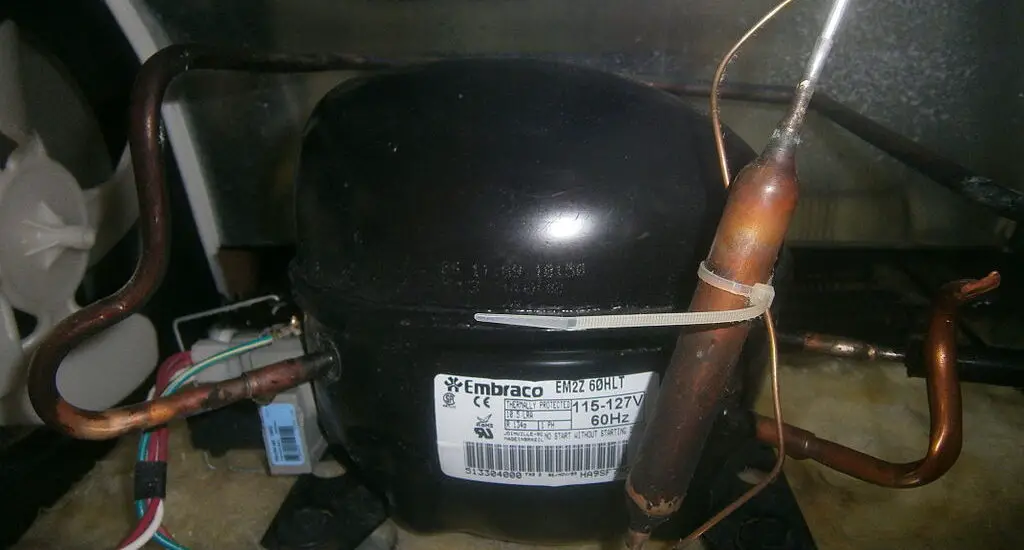Getting to know the 5 types of refrigerator compressors can offer insights into how our cooling appliances work and how best to maintain them. Each compressor type has its unique mechanism and application. In this article, we’ll delve deep into their functionalities, offering clear explanations that’ll make you feel like an expert by the end!

Table of Contents
1. Reciprocating Compressor
The reciprocating compressor, sometimes referred to as a piston compressor, is among the oldest and most widely used types in refrigeration systems. It gets its name from the reciprocating motion (back and forth movement) of its piston within a cylinder. This compressor works in a sequence of four primary steps:
Intake: As the piston moves down the cylinder, a vacuum is created. This vacuum causes the intake valve to open, allowing the refrigerant gas to flow into the cylinder.
Compression: Once the cylinder is filled, the piston starts its upward journey, compressing the refrigerant gas. As the pressure builds, the intake valve closes.
Discharge: As the piston reaches the peak of its upward movement, the compressed refrigerant gas is pushed out through the discharge valve into the refrigeration system.
Exhaust: Post-discharge, the piston returns to its initial position, pushing out any remaining gas in preparation for the next cycle.
The simplicity and robustness of its design make the reciprocating compressor highly reliable. However, due to its multiple moving parts, regular maintenance like lubrication is essential to prevent wear and tear.
2. Rotary Compressor
The rotary compressor operates on a principle of rotary motion, different from the back-and-forth movement of the reciprocating type. It uses a roller placed eccentrically inside a cylinder and wall seals to keep the refrigerant trapped between the roller and the cylinder. Here’s how it functions:
Intake: As the roller rotates away from the intake valve, refrigerant gas is drawn into the space created.
Compression: As the roller continues its rotation, the space housing the refrigerant gas reduces, leading to its compression.
Discharge: Once fully compressed, a port opens, allowing the high-pressure refrigerant gas to be discharged into the system.
Given its design, the rotary compressor tends to be quieter and more efficient in its energy use, especially in continuous operation scenarios, as compared to reciprocating compressors.
3. Scroll Compressor
A scroll compressor is relatively modern and utilizes two spiral-shaped scroll components. One scroll remains stationary, while the other orbits (but doesn’t rotate) around it, creating pockets of trapped refrigerant. The mechanism goes as follows:
Intake: As the moving scroll orbits, it draws refrigerant into the outer pocket.
Compression: The refrigerant gets trapped in the increasingly smaller pockets as the scroll continues its movement, leading to compression.
Discharge: The refrigerant, once compressed, is pushed to the center of the scroll and discharged through a port.
Due to fewer moving parts, scroll compressors are quieter, have a longer lifespan, and can be more energy-efficient than other types.
Check out these other articles…
Norcold RV Refrigerator Compressor Not Turning On: Easy Fix
Refrigerator Compressor Runs for 5 Seconds: Quick Solutions
Refrigerator Compressor Upside Down: 5 Easy Steps to Fix It
Which Type of Compressor is Best for Refrigerator? Revealed
Refrigerator Compressor Vacuum Pressure: Comprehensive Guide
4. Screw Compressor
Screw compressors, aptly named because of their screw-like rotors, are predominantly found in industrial applications. They comprise two helical rotors that mesh together. The functioning is as follows:
Intake: As the rotors turn, spaces are created, drawing in the refrigerant gas.
Compression: As the screws continue to rotate, the space housing the refrigerant decreases, compressing the gas.
Discharge: Compressed refrigerant exits through a discharge port at the end of the screws.
Screw compressors are valued for their capability to deliver a consistent and continuous refrigerant flow, making them especially suitable for large-scale operations.
5. Centrifugal Compressor
The centrifugal compressor works quite differently from the others, utilizing centrifugal force generated by a rapidly spinning impeller. The steps involved are:
Intake: Refrigerant gas is drawn into the center of the spinning impeller.
Acceleration: The impeller rapidly accelerates the refrigerant, converting its gaseous state into high-speed kinetic energy.
Diffusion: The high-speed gas then moves through a diffuser, where its speed decreases, leading to an increase in pressure.
Centrifugal compressors are best suited for very large refrigeration systems due to their ability to handle vast volumes of refrigerant, and because their efficiency increases with capacity.